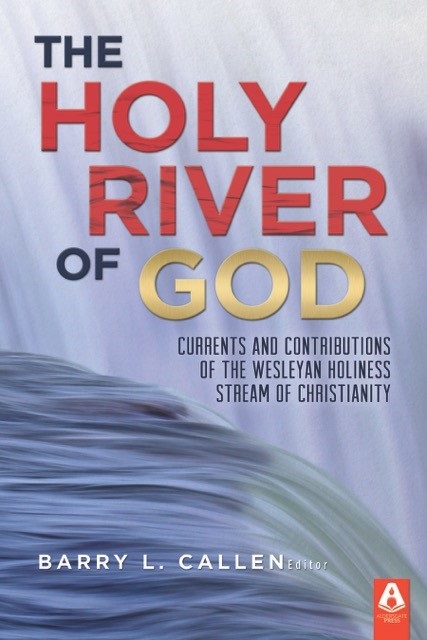The Holy River of God: Currents and Contributions of the Wesleyan Holiness Stream of Christianity
 Barry L. Callen, ed., The Holy River of God: Currents and Contributions of the Wesleyan Holiness Stream of Christianity (Aldersgate Press, 2016), 274 pages, ISBN 9781600393099.
Barry L. Callen, ed., The Holy River of God: Currents and Contributions of the Wesleyan Holiness Stream of Christianity (Aldersgate Press, 2016), 274 pages, ISBN 9781600393099.
The very mention of holiness can conjure up images of dower saints dressed in black garb, expressionless countenances, and a total lack of joy or fun. Think American Gothic without the pitchfork. The Holy River of God points to a picture of Christian holiness that is living, vibrant, engaged, and filled with joyous expectation. In the opening sentences, the holiness stream of Christian faith is described as “wide and deep,” “full of life and inspires life wherever it goes” (page 3). The book is a collection of chapters written by authors representing a wide variety of Christian denominations. The entire work is edited by Barry Callen faculty member of Anderson University, editor of the Wesleyan Theological Journal, and an editor at Aldersgate Press.
The vision of holiness that is characteristic of those who participate in the river is a work of the Spirit carried out as a “steady stream of purifying love” (page 6). It is “God’s holiness proceeding from love,” which “brings life wherever it goes in the world.” Wherever this holiness stream flows, those who choose to immerse themselves in it are transformed. They become the “reflection of God, … compelled by love, … to the end that lives are restored, systems are redeemed, and all of creation is being made new” (page 6).
The roots for this vision of holiness are found in the theology of John Wesley. However, Wesleyan holiness is by no means monolithic. How Wesleyan holiness is understood and implemented is widely diverse. This diversity is not viewed as an impediment, but is an asset. It deepens the movement to provide a “fuller vision of God’s holiness and love” (page 8).
The biblical basis of this holiness focus is based in God’s command for his people to be holy (1 Peter 1:14-16). “The entire biblical narrative is about holiness granted, lost, and recovered” (page 15). Throughout the Church’s history this holiness tradition has been manifested in Catholicism, both Roman and Orthodox, in the Radical Reformation, especially in Great Britain in the ministries of John and Charles Wesley, in the US in the 19th century, and in the 20th century with the rise of Pentecostalism. Each expression was a “fresh search for a credible Christian holiness that truly transforms lives and advances the kingdom of God on earth” (page 18).
After a few short chapters on the prominent characteristics of Wesleyan Holiness and the development of Wesley’s teachings in the US and internationally, the book goes on to describe the formation of the Wesleyan Holiness Connection and those denominations that are part. The Wesleyan Holiness Connection, or WHC, was principally founded by Kevin Mannoia. He describes the connection as an idea that formed over a long period of time through conversations, meetings, and study groups (page 143). The first of those conversations occurred in 2002 at a breakfast attended by Mannoia and a few friends. They realized that churches that possessed a holiness heritage lacked a means of sharing the common mission to spread scriptural holiness across the land (page 145). With the help of additional scholars, Mannoia formed the Wesleyan Holiness Study Project. The Project consisted of about 40 scholars from 13 different historical Wesleyan-Holiness denominations. Their objective was to “commit to a fresh articulation of holiness in the 21st century” (page 145). The Project produced two significant documents: The Holiness Manifesto, and Fresh Eyes on Holiness: Living Out the Holiness Manifesto. In September of 2006, at the end of the Project, those who participated met to work out their next steps. They agreed that there was a future for the infant movement, and the Wesleyan Holiness Connection was born. The Connection has since grown to consist of several regional networks throughout the US, Brazil, Kenya, the Philippines, and the United Kingdom as well as a collection of associated ministries and a publishing house, Aldersgate Press.
Category: Church History, Summer 2017


